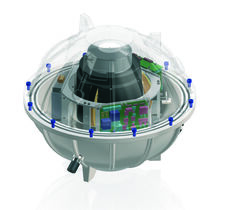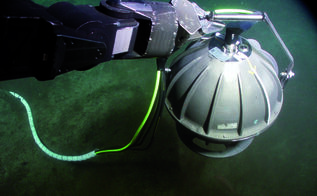
Chapter 2. Introduction
Thank-you for purchasing a Güralp Orcus Ocean Bottom Seismometer.

2.1 Description
The Orcus is a state-of-the-art, multi-sensor, permanent ocean-bottom seismometer comprising:
A 3T broadband seismometer sensor. The frequency range and sensitivity are engineered to fit the requirement of the project. The specifications of the 3T sensor are typically: 120 s to 50 Hz frequency response and an output sensitivity of 2 x 750 V/m/s
A 5T strong-motion accelerometer. The frequency range and gain are engineered to fit the requirement of the project. The specifications of the 5T sensor are typically: DC to 100 Hz frequency response with a gain of ±2 g full scale output.
An Affinity 24-bit, eight channel digitiser module
A motorised gimbal levelling system able to compensate for ±26° of tilt.
The Orcus is suitable for deploying at water depths of up to 4000 m and is designed for cable-to-shore or cable-to-buoy systems for real-time data streaming and power.
Depending on the deployment depth, the unique spherical casing is composed of either duplex stainless steel or titanium to protect the instrument against water pressure and corrosion. A metal plate located on the base of the sphere maintains coupling with sea-floor sediments. The instruments are mounted in a levelling bowl connected to a turntable to provide azimuth orientation and a lead-screw to provide altitude (tilt) adjustment. This arrangement allows for correct operation when the instrument is installed at up to 26° from level. Each velocity sensor is mounted on an individual tilt-base within the levelling bowl for accurate offset-nulling. Adjusting these tilt-bases is referred to as “centring” the masses.
An optional concrete dome hood can be employed to reduce noise and protect against fish trawl nets in shallow waters.
The Orcus may be integrated with a number of additional geophysical sensors including a differential pressure gauge (DPG), absolute pressure gauge (APG), current meter, hydrophone, compass and tilt-meter.
2.2 Applications
Earthquake and tsunami early-warning
Local, regional and global seismic monitoring
Monitoring of sub-sea hazards
Permanent Reservoir Monitoring (PRM)
Permanent ocean observatories
2.3 Summary of key features
Suitable for depths of up to 4000 m (depending on sphere casing material)
Designed for cable-to-shore or cable-to-buoy systems
Optional add-on sensors
Optional concrete dome
Suitable for on-site data digitisation
Suitable either for Ethernet or Fibre Optics connection, with network timing protocol (NTP and PTP)
Deployment via winch with ROV support for deeper installations
Robust self-levelling system (up to ±26° of tilt)
